Wiltshire, in southwest England, is a county steeped in mystery, history, and natural beauty. Famed across the world for Stonehenge, Wiltshire holds some of Britain’s greatest archaeological treasures, including Avebury, Silbury Hill, and the ancient ceremonial landscape of the Salisbury Plain. Its chalk downs, carved with enigmatic white horses, stretch across wide horizons, giving the county its distinctive scenery.
But Wiltshire is not only about its prehistoric past. The county is also home to medieval towns, atmospheric villages, and stately homes that reveal the richness of its cultural heritage. Salisbury Cathedral, with its soaring spire, remains one of the most breathtaking achievements of Gothic architecture, while picturesque settlements like Lacock and Castle Combe seem almost untouched by time.
Natural wonders abound, from the vast chalk grasslands of Salisbury Plain to the wooded valleys of the Cotswolds Area of Outstanding Natural Beauty that extend into Wiltshire. The Kennet & Avon Canal winds gracefully through the county, connecting market towns and offering tranquil walking and boating opportunities.
Throughout its landscapes and towns, Wiltshire combines the mystical and the historic with the serene and the pastoral. It is a place where one can trace the footsteps of ancient peoples, marvel at medieval craftsmanship, and enjoy the quiet beauty of the English countryside.
This list of thirty highlights captures the essence of Wiltshire: its world-renowned prehistoric sites, its historic towns and villages, and its landscapes of rare beauty. Together, they tell the story of a county that has been at the heart of English history for millennia, and which continues to inspire awe and wonder today.
Avebury Stone Circle & Silbury Hill
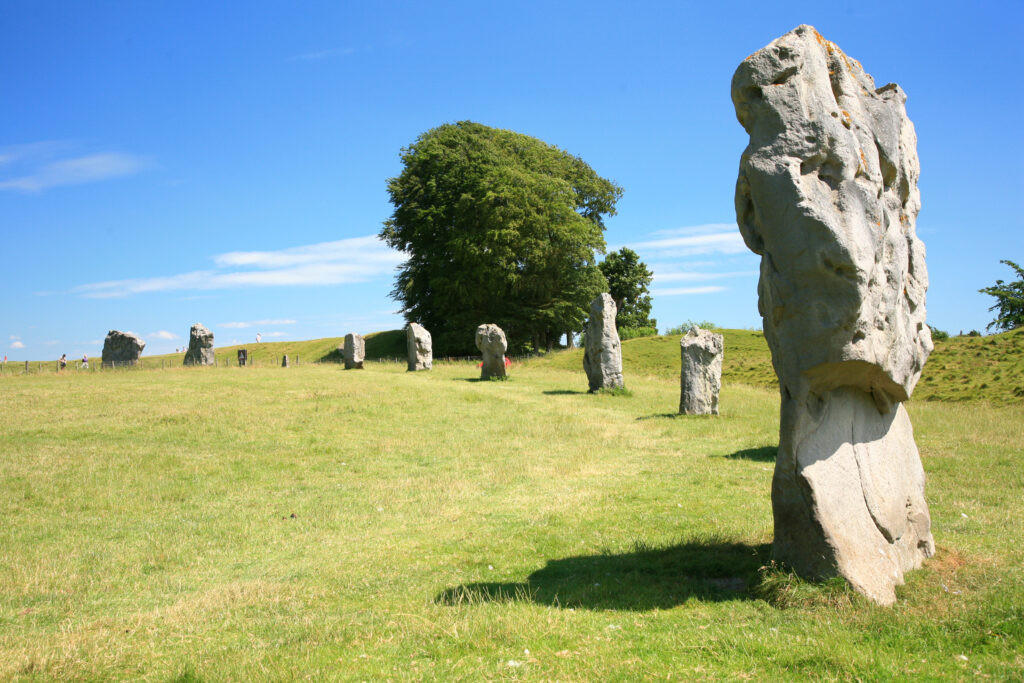
While Stonehenge is the most famous, Avebury offers an equally compelling—if less visited—prehistoric experience. Its great stone circle, the largest in the world, encompasses much of the village itself, creating a unique blend of ancient and modern life. Dating to around 2600 BC, the site once contained hundreds of standing stones, many of which still loom across fields and footpaths, accessible to visitors who can wander freely among them.
Nearby lies Silbury Hill, Europe’s largest man-made prehistoric mound, a massive earthwork as enigmatic as it is impressive. Rising 30 metres from the flat landscape, its purpose remains unknown, though it clearly had immense symbolic or ceremonial significance. Together with the West Kennet Long Barrow, these monuments form part of a wider sacred landscape that rivals Stonehenge in scale and mystery.
Walking through Avebury is an extraordinary experience: sheep graze among the stones, cottages line the circle’s edge, and the air feels infused with an ancient presence. The site’s accessibility allows for an intimacy and connection rare at such monuments.
Avebury and Silbury Hill remind us that Wiltshire’s prehistoric heritage is vast, layered, and deeply embedded in its landscapes.
Salisbury Cathedral & Close

If Stonehenge is Wiltshire’s prehistoric masterpiece, Salisbury Cathedral is its medieval crown jewel. Completed in just 38 years (1220–1258), it is one of the finest examples of Early English Gothic architecture. Its soaring spire, the tallest in England at 123 metres, dominates the surrounding countryside and continues to inspire awe centuries after it was raised.
The cathedral is renowned not only for its architecture but also for housing one of the best-preserved copies of Magna Carta (1215), displayed in its Chapter House. Visitors are drawn to its light-filled nave, intricate cloisters, and the oldest working mechanical clock in the world, dating to 1386.
Equally enchanting is the surrounding Cathedral Close, one of the largest in Britain, where elegant Georgian houses, museums, and gardens frame the cathedral in a serene setting. From here, views of the spire rising above green lawns capture the very essence of English ecclesiastical grandeur.
Salisbury Cathedral is more than a building; it is a living place of worship, music, and community. Its enduring presence links faith, history, and art in a way that remains profoundly moving to all who step inside.
Old Sarum

Before Salisbury Cathedral was built, the heart of the region was Old Sarum, a site where history stretches back thousands of years. Occupied since the Iron Age, it later became a Roman settlement, a Saxon stronghold, and eventually a Norman castle and cathedral. Perched high on an earthwork mound, Old Sarum commands sweeping views across the Wiltshire countryside, a testament to its strategic significance.
The site today is a hauntingly beautiful ruin. Visitors can explore the outlines of the Norman keep, the foundations of the first Salisbury Cathedral, and the vast earthworks that encircle the hill. Walking its ramparts gives a sense of the layered history beneath one’s feet, from prehistoric fortifications to medieval grandeur.
Abandoned in the 13th century when the cathedral and town moved to Salisbury, Old Sarum nonetheless retains an extraordinary atmosphere. Its windswept plateau and exposed ruins invite reflection on how communities shift and landscapes change.
Old Sarum is a place where the story of Wiltshire can be read in the earth itself, a site that bridges the prehistoric, Roman, Norman, and medieval ages in one evocative setting.
Castle Combe
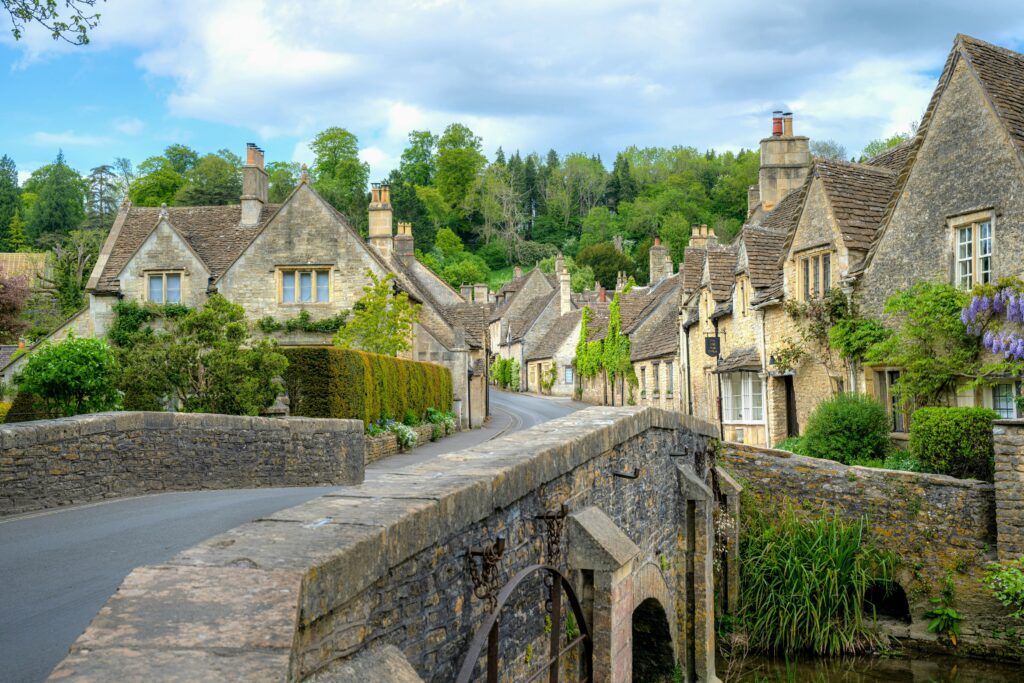
Often called “the prettiest village in England,” Castle Combe more than lives up to its reputation. Nestled in the Cotswolds Area of Outstanding Natural Beauty, the village is a picture of honey-coloured stone cottages, a medieval market cross, and a gently flowing brook crossed by an ancient stone bridge.
Castle Combe’s beauty lies in its preservation: no new buildings have been added since the 17th century, giving it a timeless quality. The Church of St Andrew, with its 13th-century tower and medieval clock, anchors the village, while the streets invite leisurely wandering past cottages adorned with flowers.
The village’s name comes from a long-vanished castle, but today its fame rests on its idyllic charm. It has been used as a film location for productions such as War Horse and Doctor Dolittle, yet despite the attention, it remains a peaceful, lived-in community.
Castle Combe is not simply a museum-piece village; it is a living example of English rural beauty, offering visitors the rare joy of stepping into a landscape seemingly untouched by time.
Lacock Village & Abbey

Lacock is a village frozen in time, its medieval streets, half-timbered houses, and stone cottages providing an authentic window into the past. Owned almost entirely by the National Trust, it has been carefully preserved, making it one of Wiltshire’s most atmospheric destinations.
At its heart stands Lacock Abbey, founded in the 13th century as an Augustinian nunnery and later converted into a grand country house. The abbey’s cloisters, with their Gothic arches, are particularly evocative, and have become famous through appearances in films such as Harry Potter and Pride and Prejudice. The surrounding gardens and woodlands add to the site’s charm.
The village itself is equally enchanting, with a medieval tithe barn, a 14th-century inn, and streets that appear untouched by modernity. Lacock has been a favourite filming location for historical dramas because of this remarkable preservation.
Beyond its cinematic fame, Lacock tells the story of England’s religious, architectural, and social history. It is a place where centuries coexist gracefully, offering visitors an immersion in heritage unlike anywhere else.
Marlborough
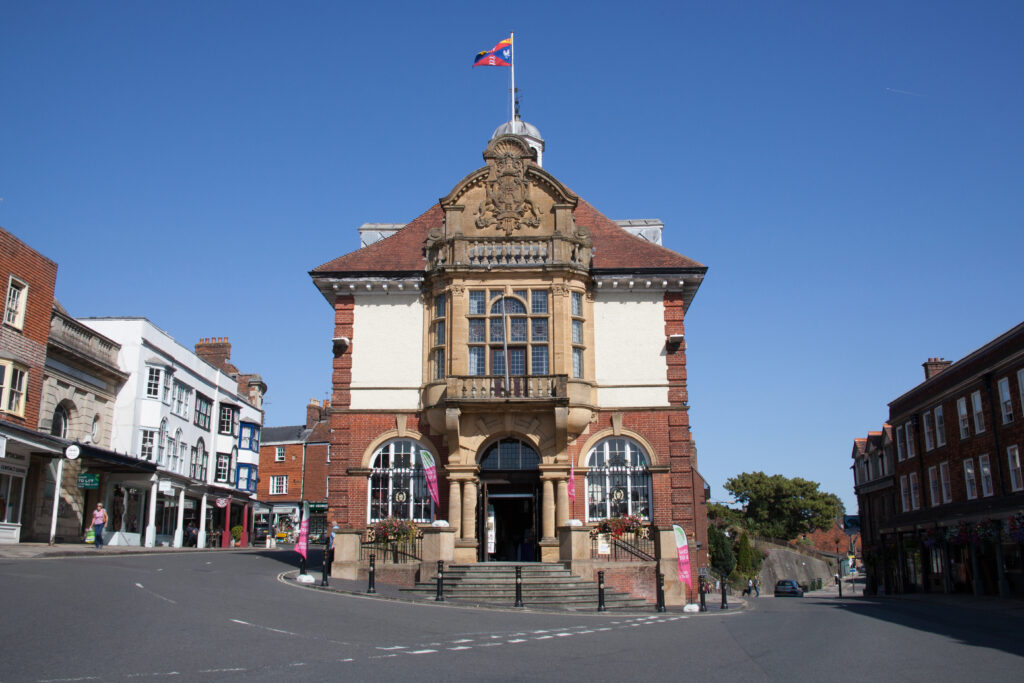
Marlborough is a historic market town whose broad High Street is one of the widest in England, lined with Georgian townhouses, timber-framed inns, and bustling shops. Its roots go back to Saxon times, and local legend claims that Merlin the wizard is buried beneath the town’s ancient mound.
The town flourished as a staging post on the London-to-Bath road, and its coaching inns remain a striking feature of the High Street. Today, Marlborough retains its lively character with weekly markets, boutique shops, and a vibrant café culture. Marlborough College, one of England’s most prestigious schools, adds an academic presence and occupies historic buildings, including a former castle site.
Nearby, the surrounding Marlborough Downs offer some of the county’s most dramatic scenery, dotted with white horses carved into chalk hillsides. Combined with the town’s cultural festivals, such as the Marlborough Literature Festival, this creates a community rich in heritage and creativity.
Marlborough embodies the fusion of historic charm and cultural vitality, making it one of Wiltshire’s most attractive towns.
Devizes & the Kennet & Avon Canal

Devizes is a quintessential Wiltshire market town, with roots in the medieval period and a rich tapestry of architecture spanning centuries. Its centre is dominated by the Market Place, framed by Georgian facades and lively with weekly markets that have been held here for hundreds of years.
The town is perhaps most famous for its connection to the Kennet & Avon Canal, a remarkable feat of 19th-century engineering. Just outside Devizes lies the Caen Hill Locks, a flight of 29 locks rising in a dramatic staircase up the hillside. It remains one of Britain’s greatest canal landmarks, drawing boaters and walkers alike.
Devizes is also home to the Wiltshire Museum, where some of the most important Bronze Age finds from Stonehenge and Avebury are displayed, adding to its cultural significance.
With its blend of medieval streets, canal-side beauty, and historical treasures, Devizes captures both the energy of a traditional market town and the serenity of the waterways that flow through it.
Longleat House & Safari Park
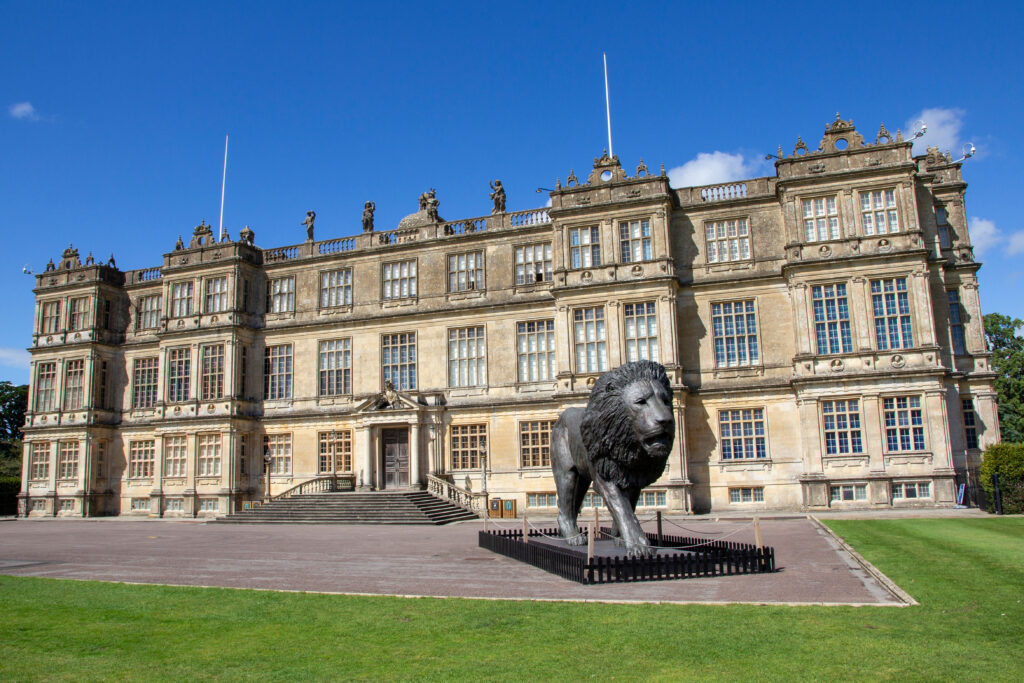
One of England’s grandest stately homes, Longleat House is a masterpiece of Elizabethan architecture set within vast landscaped grounds. Built in the 16th century for Sir John Thynne, it remains the seat of the Marquesses of Bath and is renowned for its stunning architecture, art collections, and gardens designed by Capability Brown.
What makes Longleat truly unique, however, is its pioneering Safari Park, opened in 1966 as the first of its kind outside Africa. Home to lions, tigers, giraffes, and many other species, the park transformed Longleat into a destination where heritage and wildlife coexist. Visitors can explore both the grand state rooms of the house and the safari park’s immersive wildlife experiences in a single day.
The estate also features a hedge maze, adventure playgrounds, and exhibitions, ensuring its appeal to all ages. Longleat is not simply a stately home but an innovative and dynamic attraction that blends history, art, and the natural world.
Wilton House

Wilton House, the ancestral home of the Earls of Pembroke for over 400 years, is one of Wiltshire’s grandest stately houses. Set within 21 acres of landscaped parkland beside the River Nadder, the house is an architectural jewel, blending Elizabethan foundations with later Palladian additions.
Inside, Wilton is renowned for its exquisite staterooms, including the Double Cube Room, often described as one of the finest rooms in England. Lavishly decorated with portraits by Van Dyck, this space epitomises aristocratic grandeur. The house also houses an outstanding art collection, featuring works by Rembrandt, Rubens, and Gainsborough.
The grounds, landscaped in part by Capability Brown, include sweeping lawns, classical bridges, and ornamental gardens that provide a serene setting. Wilton House has frequently appeared in film and television, from The Crown to Pride and Prejudice, further cementing its cultural status.
Wilton House is more than a stately home; it is a living testament to England’s artistic, political, and architectural heritage.
Stourhead Gardens

Stourhead, managed by the National Trust, is one of the most celebrated landscape gardens in Britain. Created in the 18th century by Henry Hoare II, it epitomises the ideals of the English landscape movement, designed as a living work of art.
At its heart lies a great lake, around which temples, grottoes, bridges, and classical follies are carefully arranged to create vistas of breathtaking beauty. The Pantheon and the Temple of Apollo stand as highlights, evoking the grandeur of ancient Rome while perfectly framed by rolling Wiltshire hills.
Stourhead is especially famous in autumn, when its woodlands blaze with colour, and in spring, when rhododendrons and azaleas transform the gardens into a palette of pastels. The estate also includes a grand Palladian mansion filled with art and history.
Walking through Stourhead feels like stepping into a painting, where every view is composed to inspire wonder. It is one of the greatest achievements of landscape design in Europe.
Corsham
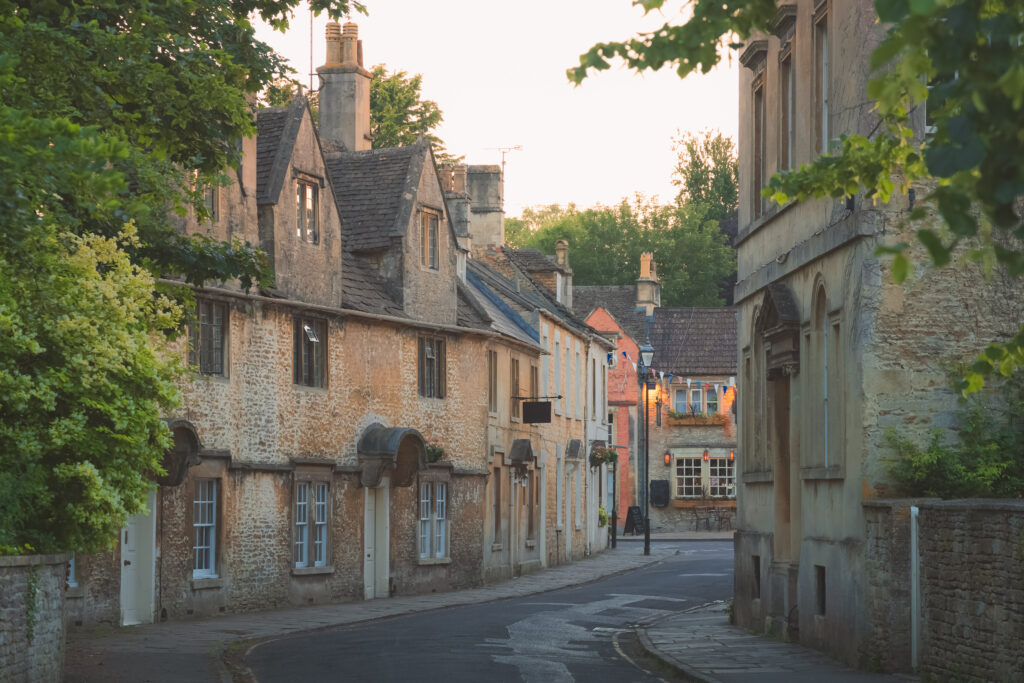
Corsham is a charming market town on the edge of the Cotswolds, known for its honey-coloured stone buildings and unspoilt character. Its High Street is lined with Georgian architecture, independent shops, and cosy inns, creating an atmosphere of timeless appeal.
At the heart of the town lies Corsham Court, an Elizabethan mansion with later alterations by Capability Brown and John Nash. It is famed for its collection of Old Masters, including works by Van Dyck, Rubens, and Reynolds. The house is still privately owned but remains open to visitors, offering a rare blend of grandeur and intimacy.
Corsham is also noted for its resident peacocks, which wander freely through the town, delighting visitors and adding to its quirky charm.
With its historic architecture, artistic heritage, and proximity to both Bath and the Cotswolds, Corsham offers a unique combination of elegance and community spirit, making it one of Wiltshire’s hidden treasures.
Bradford-on-Avon
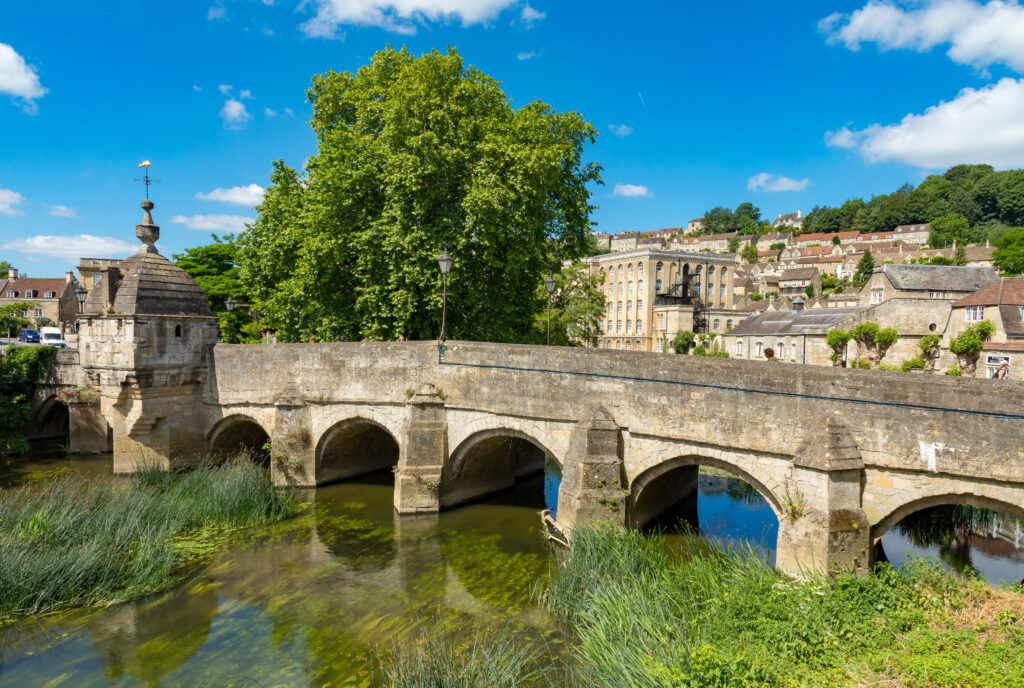
Bradford-on-Avon is one of Wiltshire’s most picturesque towns, set on the banks of the River Avon and characterised by golden limestone buildings, narrow streets, and a graceful medieval bridge. Its riverside setting gives the town a tranquil atmosphere, while its rich history adds depth to its charm.
The town boasts one of the best-preserved Saxon churches in England, St Laurence’s Church, which dates back to the 10th or 11th century. Equally striking is the medieval Tithe Barn, a vast 14th-century structure that speaks to the town’s agricultural past.
During the Industrial Revolution, Bradford-on-Avon grew as a centre of wool and weaving, leaving a legacy of elegant Georgian townhouses and former mills. Today, many of these buildings house cafés, shops, and galleries, adding vibrancy to its historic fabric.
Bradford-on-Avon is also a gateway to the Kennet & Avon Canal, offering beautiful walks and boat trips through Wiltshire’s countryside. Its combination of riverside beauty, ancient architecture, and cultural vitality makes it one of the county’s most rewarding destinations.
Malmesbury Abbey & Town
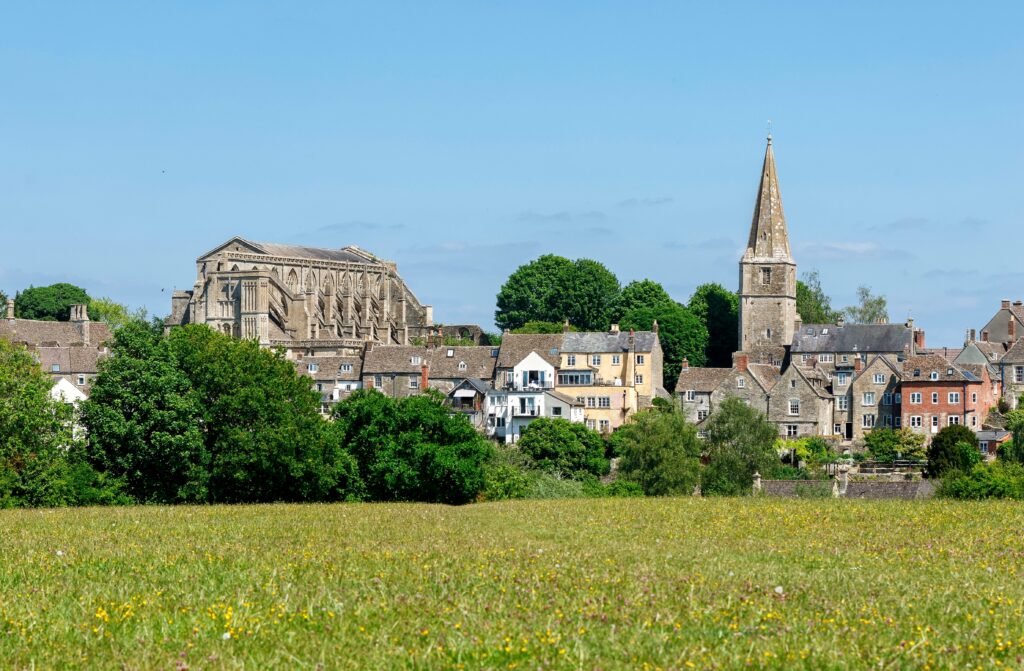
Perched on a hill above the River Avon, Malmesbury is one of England’s oldest towns, with a history stretching back to the Iron Age. Its crowning glory is Malmesbury Abbey, a once-mighty Benedictine monastery that was founded in the 7th century. Though partially ruined after the Dissolution, the abbey remains magnificent, with its Romanesque architecture, soaring arches, and richly carved details.
Malmesbury’s past is rich with remarkable figures: the monk Eilmer of Malmesbury famously attempted flight in the 11th century by strapping wings to his arms, while the scholar William of Malmesbury was one of medieval England’s greatest historians.
The town itself is a delight, with winding streets, historic inns, and a bustling market square. Its setting, surrounded by rolling countryside, adds to its charm. Malmesbury has retained its sense of community while honouring its extraordinary past, making it a gem of both heritage and character.
White Horses of Wiltshire
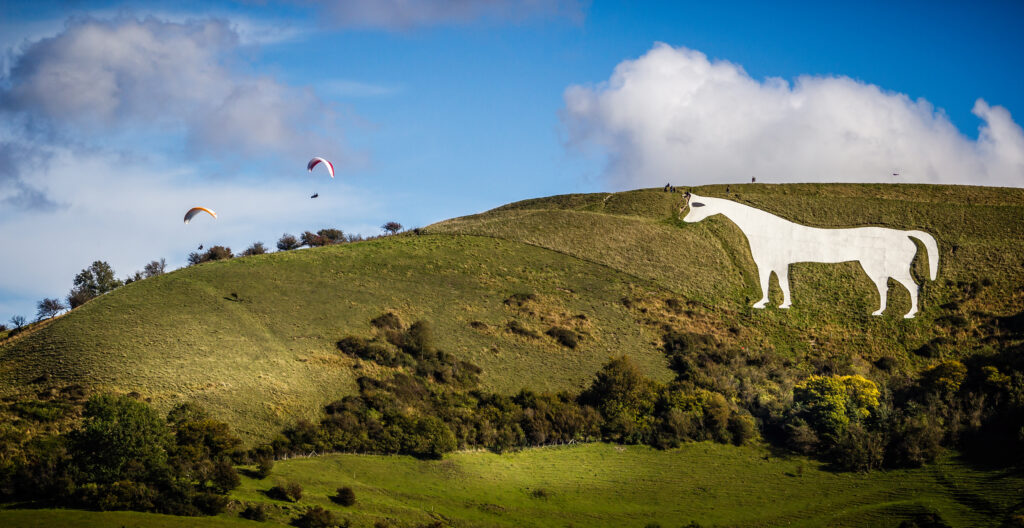
Few symbols are as closely associated with Wiltshire as its mysterious white horses, giant figures carved into the county’s chalk hillsides. These striking hill figures, created by exposing the white chalk beneath the grass, date from various periods—some as old as the 18th century, others more modern.
The most famous is the Westbury White Horse, believed to commemorate King Alfred’s victory at the Battle of Ethandun in 878 AD. Equally captivating is the Alton Barnes White Horse, carved in 1812, which dominates the Marlborough Downs and remains visible for miles.
These figures are both landmarks and works of art, rooted in local identity and folklore. Walking trails across the downs often bring visitors up close to these immense creations, where the scale and effort involved in their construction can truly be appreciated.
The white horses are more than decorative; they are enduring symbols of Wiltshire’s landscapes, expressing the county’s deep connection to its land and history.
Chippenham
Chippenham is one of Wiltshire’s largest market towns, located on the River Avon and often described as the “Gateway to the Cotswolds.” Its history stretches back to Saxon times, when it was a royal vill of Alfred the Great, and it has remained an important settlement ever since.

At the heart of the town lies the Market Place, where weekly markets continue a tradition dating back centuries. The Yelde Hall, a timber-framed medieval guildhall, stands as one of Chippenham’s most distinctive landmarks. Its winding streets reveal a mixture of historic coaching inns, Georgian terraces, and Victorian buildings, reflecting the town’s long prosperity.
Chippenham is also known for its cultural life. The Chippenham Folk Festival is one of the biggest events of its kind in England, drawing performers and visitors from across the country. The town also serves as a great base for exploring nearby attractions such as Lacock and Castle Combe.
Balancing heritage, markets, and modern vibrancy, Chippenham embodies Wiltshire’s blend of tradition and community spirit.
Calne & Bowood House
Calne is a historic market town with a strong industrial legacy, once thriving on wool production and later famous for its association with the Harris family, pioneers of the British bacon-curing industry. Its story reflects the adaptability of Wiltshire towns through changing times.
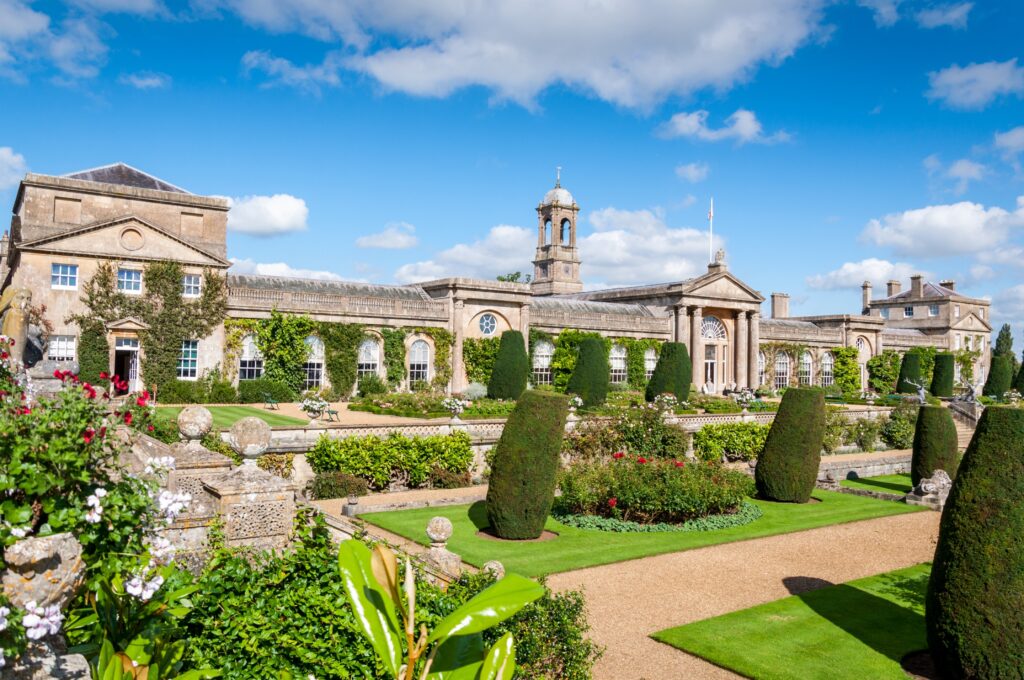
Nearby lies the spectacular Bowood House, one of the county’s greatest stately homes. The 18th-century mansion, seat of the Lansdowne family, is set within a vast Capability Brown-designed parkland. The house is renowned for its opulent interiors, including Robert Adam rooms and a rich collection of art and antiques.
The gardens are equally magnificent, with sweeping lawns, a lake, woodland gardens, and the stunning Italianate Terraces. Bowood also has strong historical significance: it was here that Joseph Priestley discovered oxygen in 1774, a milestone in the history of science.
Together, Calne and Bowood represent both the industrious and the aristocratic sides of Wiltshire’s past, offering visitors a fascinating contrast.
Cranborne Chase & West Wiltshire Downs
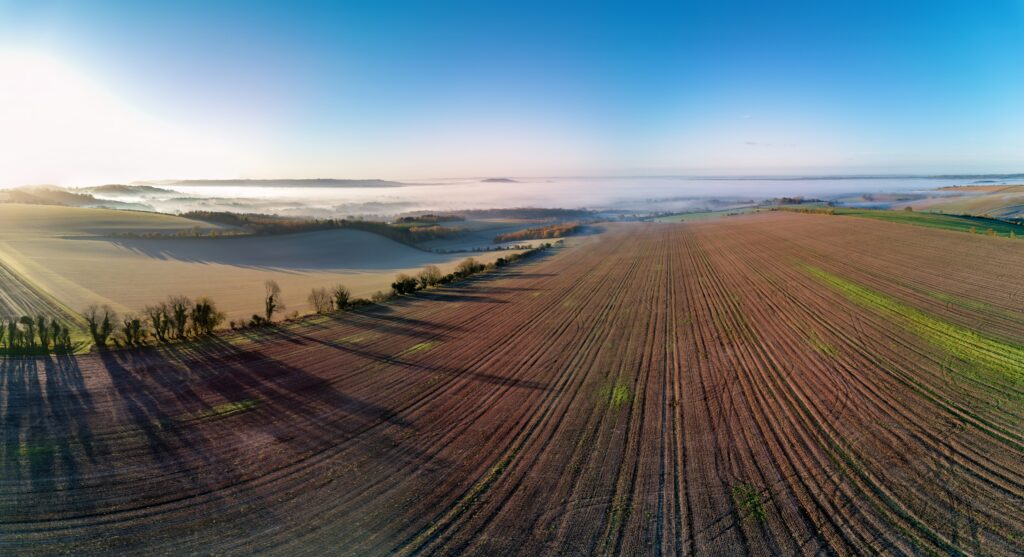
The Cranborne Chase and West Wiltshire Downs Area of Outstanding Natural Beauty is one of the county’s most breathtaking landscapes, covering rolling chalk downland, wooded valleys, and historic sites. Stretching across Wiltshire, Dorset, Hampshire, and Somerset, it is a vast protected area where nature and history intertwine.
This landscape has been inhabited for thousands of years, and its chalk ridges are dotted with prehistoric earthworks, barrows, and hillforts. The views from sites like Win Green Hill, the AONB’s highest point, are particularly awe-inspiring. Ancient drove roads and sunken lanes crisscross the downs, offering endless opportunities for walking and exploration.
The area is also rich in wildlife, with chalk grasslands supporting rare butterflies and wildflowers. Villages tucked into valleys, with their stone cottages and historic churches, add to the area’s timeless atmosphere.
Cranborne Chase is not only a place of natural beauty but also of cultural depth, where the layers of England’s rural history remain etched into the land.
Trowbridge

Trowbridge, Wiltshire’s county town, has a history shaped by the woollen cloth industry, which once made it one of the most prosperous textile centres in England. This industrial heritage is still visible in the grand former mills that line the town, many of which have been repurposed into modern spaces for shops, businesses, and culture.
The Trowbridge Museum tells the story of this transformation, charting the town’s rise as the “Manchester of the West” and its role in shaping Wiltshire’s economy. The museum also celebrates the lives of local people who worked in the mills, weaving the fabric of the town’s identity.
Trowbridge’s town centre combines Georgian architecture, historic churches, and modern amenities. Its parks, such as Trowbridge Park, provide green spaces for relaxation, while the nearby Kennet & Avon Canal connects the town to the wider landscape.
As the county town, Trowbridge plays an important civic role, but its roots in industry and its adaptability give it a character that balances tradition with modern life.
Warminster & Cley Hill
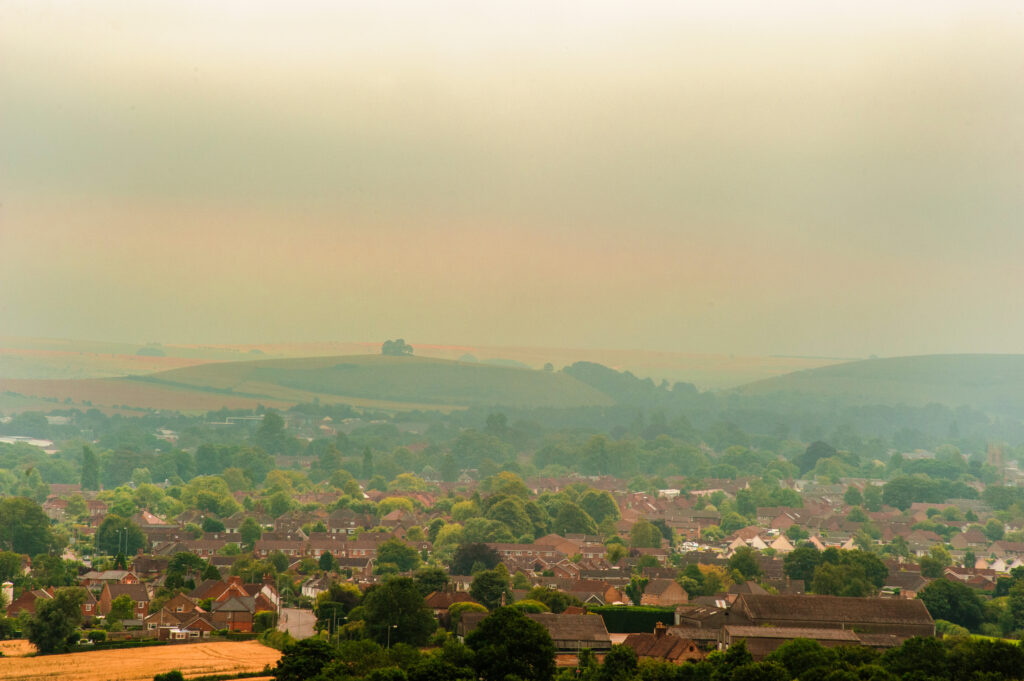
Warminster, nestled at the edge of Salisbury Plain, is a market town with a history stretching back to Saxon times. The town grew during the wool trade but later became known for its military connections, due to its proximity to the garrison town of Westbury and Salisbury Plain’s training grounds.
One of Warminster’s most famous landmarks is Cley Hill, a dramatic chalk hill owned by the National Trust. Rising steeply from the surrounding landscape, it offers panoramic views across Wiltshire, Somerset, and beyond. The hill is steeped in folklore, with tales of giants and supernatural happenings, which have fuelled its reputation as a place of mystery.
Warminster is also a gateway to nature, with Longleat Safari Park and stately Longleat House close by. Together, the town and its iconic hill represent Wiltshire’s blend of history, folklore, and scenic drama.
Amesbury
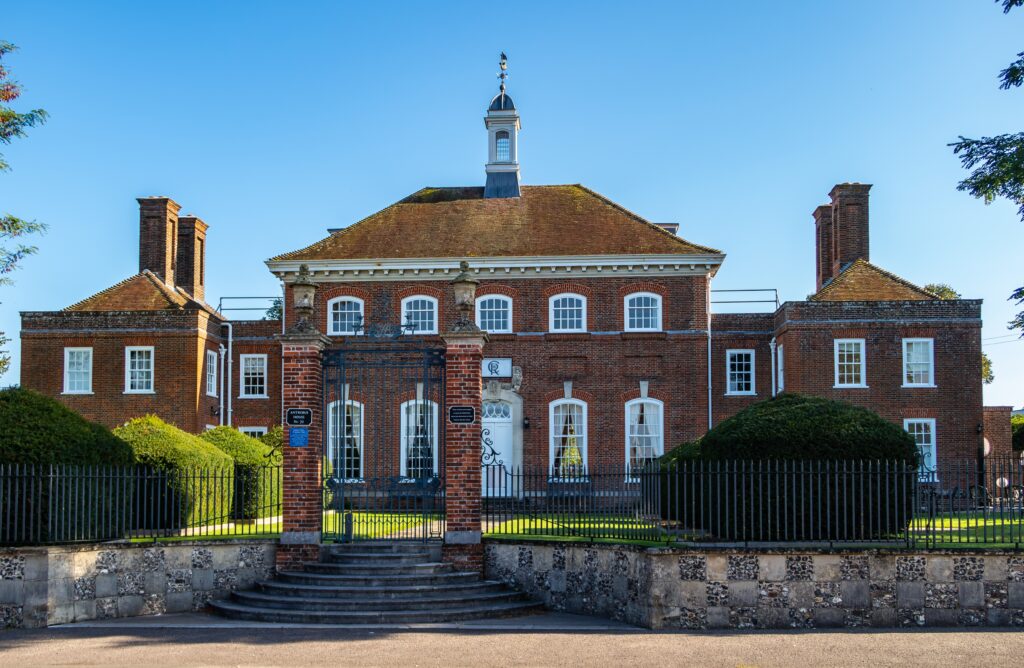
Amesbury holds the distinction of being Britain’s oldest continuously inhabited settlement, with evidence of occupation stretching back over 10,000 years. Its location on the banks of the River Avon, close to the great prehistoric monuments of Salisbury Plain, makes it a place of extraordinary significance.
Most famously, Amesbury lies just a stone’s throw from Stonehenge, and it is believed that many of the people who constructed the monument lived in or around the town. Excavations have uncovered remarkable prehistoric sites nearby, such as the Neolithic settlement at Durrington Walls.
The town itself has a charming character, with a historic church dedicated to St Mary and St Melor and a lively local community. Legends also connect Amesbury with Guinevere, wife of King Arthur, who is said to have retired to a convent here.
Amesbury stands as a living link between the ancient and the modern, rooted in human history yet still thriving today.
Pewsey Vale
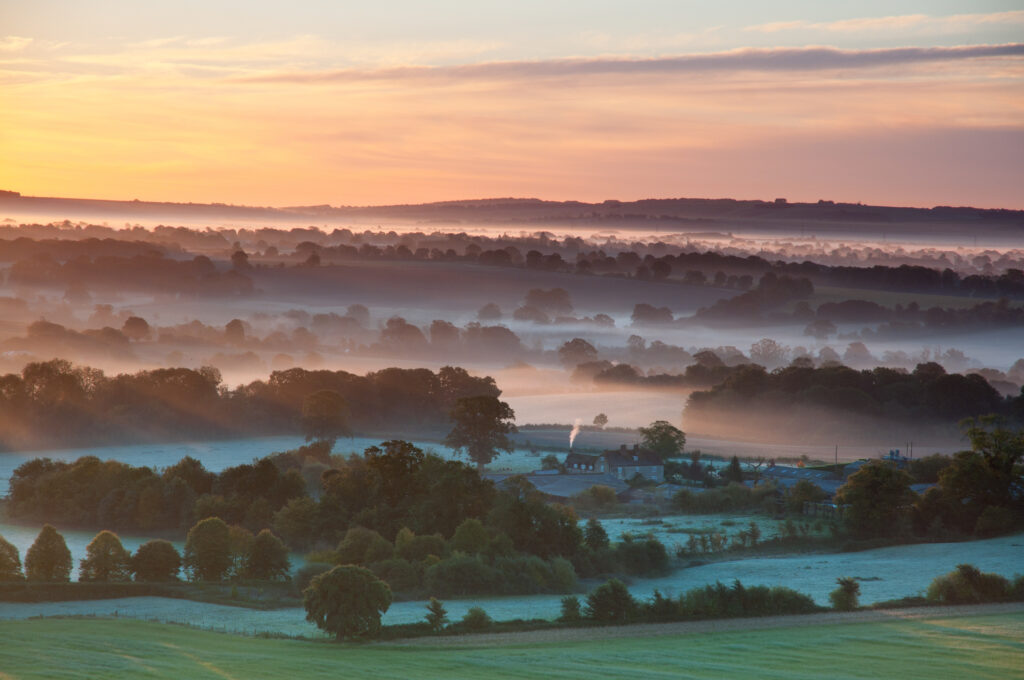
The Vale of Pewsey is a sweeping landscape of chalk downs, fertile farmland, and quaint villages, offering some of Wiltshire’s most evocative countryside. It lies between the Marlborough Downs and Salisbury Plain, creating a natural corridor rich in heritage and folklore.
The vale is dotted with prehistoric remains, including barrows and earthworks, and is closely associated with Wiltshire’s famous white horses carved into the hillsides. The Pewsey White Horse, created in 1937, continues this long tradition.
The village of Pewsey itself is a friendly community with a Saxon church and a lively annual Pewsey Carnival, one of the oldest in England. The Kennet & Avon Canal runs through the vale, providing tranquil walking and boating opportunities against a backdrop of rolling hills.
The Vale of Pewsey epitomises rural Wiltshire: a timeless landscape shaped by nature, history, and enduring traditions.
Swindon & STEAM Museum
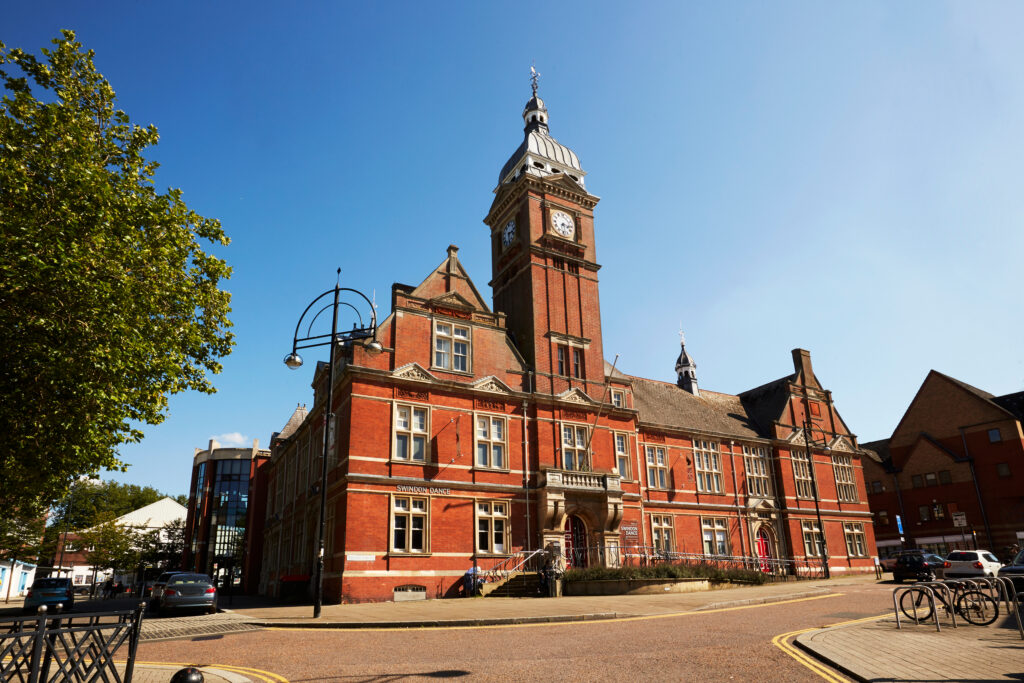
Swindon, Wiltshire’s largest town, is best known for its industrial heritage and innovation. In the 19th century, it became a centre of the Great Western Railway, with Isambard Kingdom Brunel establishing the Swindon Works, which grew into one of the most important railway engineering complexes in the world.
This legacy is celebrated at the STEAM Museum of the Great Western Railway, located in the restored railway works. The museum tells the story of the men and women who built and operated the railway, with beautifully preserved locomotives and interactive exhibits.
Beyond its railway heritage, Swindon has grown into a vibrant modern town, with cultural venues, shopping centres, and green spaces such as Lydiard Park, a historic estate with a grand Palladian house and landscaped grounds.
Swindon represents the industrial and modern face of Wiltshire, balancing innovation with a strong sense of heritage.
Stonehenge
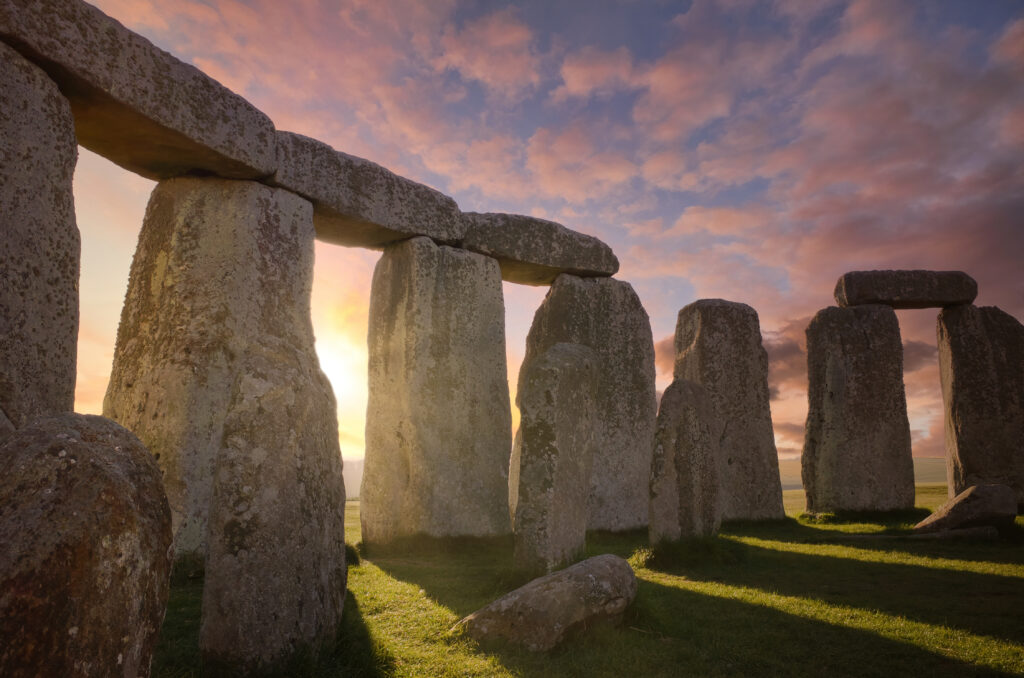
Few places on earth command the same awe as Stonehenge, the most iconic prehistoric monument in Britain and perhaps the world. Standing on Salisbury Plain, this ring of massive sarsen stones and smaller bluestones has captivated human imagination for millennia. Built in stages between 3000 and 2000 BC, its exact purpose remains a mystery, though most believe it was a ceremonial or astronomical site, aligned with the solstices.
Approaching Stonehenge, visitors are struck by both the size of the stones and the precision with which they were arranged. Some weigh up to 25 tons and were transported from as far as Wales, an extraordinary feat in the Neolithic age. The circle’s alignment with the midsummer sunrise and midwinter sunset suggests a deep connection to ancient beliefs about the cosmos and cycles of life.
The modern visitor experience enhances the sense of wonder. A world-class visitor centre provides immersive exhibitions and Neolithic reconstructions, while shuttle buses or walking trails lead to the monument itself. Standing at the perimeter, one can feel both the remoteness of time and the enduring human urge to create meaning in the landscape.
Stonehenge is not merely a monument; it is a symbol of mystery and continuity, linking us to the distant past in ways both tangible and spiritual.

